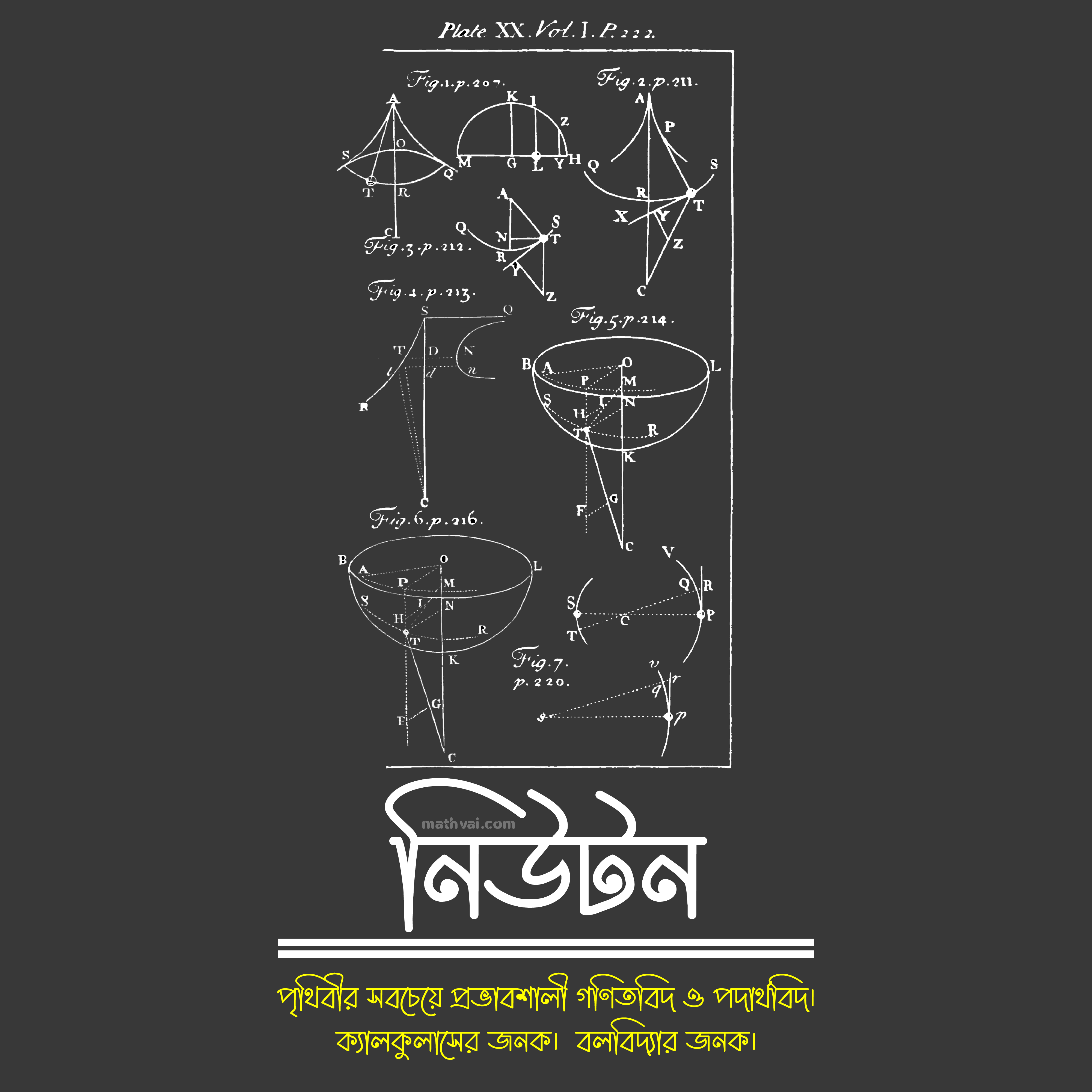ম্যাথ পোস্টার ও ভিজুয়াল ম্যাথ
download High Resolution math poster & visuals created by your "Math Vai".

Created by - Tanvir Rony
All Math Symbol
গণিতে ব্যবহৃত প্রতীকসমূহ
More detailsPublished - Thu, 14 Sep 2023

Created by - Tanvir Rony
roman numeral
১ থেকে ২০০০ পর্যন্ত রোমান সংখ্যা
More detailsPublished - Wed, 20 Sep 2023

Created by - Tanvir Rony
Conic all formula
পরাবৃত্ত, উপবৃত্ত, অধিবৃত্ত - কনিকের সকল সূত্রের দেয়াল পোস্টার।
More detailsPublished - Fri, 22 Sep 2023


Created by - Tanvir Rony
Newton
Sir Isaac Newton, an English mathematician, physicist, and astronomer, stands as a colossal figure in the history of science, primarily renowned for his pioneering contributions to calculus and mechanics. Newton's seminal work, "Philosophiæ Naturalis Principia Mathematica" ("Mathematical Principles of Natural Philosophy"), published in 1687, revolutionized scientific thought. Within this magnum opus, Newton formulated his three fundamental laws of motion—laws that laid the groundwork for classical mechanics. These laws elucidated how objects behave when subjected to forces, defining inertia, acceleration, and action-reaction relationships, providing a comprehensive framework for understanding the motion of celestial bodies and terrestrial objects. Central to Newton's mechanics was his universal law of gravitation, which mathematically described how every mass in the universe attracts every other mass, a concept that profoundly altered our perception of the cosmos and led to a deeper comprehension of celestial mechanics. Moreover, Newton's development of calculus independently of Gottfried Wilhelm Leibniz established a mathematical framework to describe rates of change and solve problems in various fields, especially physics. Calculus, comprising differential and integral calculus, became an indispensable tool for understanding motion, change, and physical phenomena. Newton's work in calculus and its integration into the realm of physics provided scientists with the means to explore and articulate complex phenomena, from describing planetary orbits to analyzing the behavior of moving objects on Earth. His conceptualization of derivatives and integrals expanded the realm of mathematics, enabling scientists and engineers to model and predict phenomena previously beyond mathematical reach. Newton's contributions in both calculus and mechanics were transformative, sparking a scientific revolution and profoundly influencing subsequent generations of scientists and mathematicians. His meticulous observations, mathematical prowess, and revolutionary insights reshaped the scientific landscape, cementing his place as one of the greatest scientific minds in history. Newton's work not only laid the foundation for classical physics but also established a framework for future scientific inquiry, inspiring centuries of research and discovery in fields ranging from astronomy and physics to engineering and mathematics. His legacy continues to reverberate through the principles and methodologies that underpin modern scientific exploration and understanding of the natural world.
More detailsPublished - Fri, 20 Oct 2023


Created by - Tanvir Rony
fibonacci
Leonardo of Pisa, more commonly known as Fibonacci, was a 13th-century Italian mathematician who introduced to the Western world a numerical sequence that would become one of the most famous in mathematics—the Fibonacci sequence. Born around 1170, Fibonacci was instrumental in spreading the Hindu-Arabic numeral system throughout Europe, which revolutionized arithmetic and mathematics. However, his most enduring legacy lies in his discovery of the sequence that bears his name. The Fibonacci sequence begins with two numbers, 0 and 1. Each subsequent number in the sequence is the sum of the two preceding numbers. So, the sequence goes: 0, 1, 1, 2, 3, 5, 8, 13, 21, and so on, continuing indefinitely. This sequence possesses remarkable properties that appear in various natural phenomena, making it a fascinating area of study not only in mathematics but also in fields such as biology, art, and architecture. Fibonacci encountered the sequence while studying the breeding patterns of rabbits in his book "Liber Abaci" ("The Book of Calculation"). In one of its chapters, he presented a problem involving the growth of a hypothetical rabbit population over the course of several months. He devised a model where rabbits breed in pairs and each pair produces a new pair every month, starting from the second month. This problem led to the formulation of the Fibonacci sequence as a solution to tracking the number of rabbits after each month. What makes the Fibonacci sequence intriguing is its prevalence in nature. It appears in the branching of trees, the arrangement of leaves, the spirals of shells, the petals of flowers, and even in the proportions of the human body. The sequence manifests in the spiral patterns found in sunflowers, pinecones, and the shells of snails, exhibiting a mathematical elegance that mirrors the beauty of the natural world. Furthermore, the golden ratio, often associated with the Fibonacci sequence, is derived from its consecutive terms. As the sequence progresses, the ratio between consecutive Fibonacci numbers approximates the golden ratio—approximately 1.6180339887. This ratio is renowned for its aesthetic appeal and is found in art, architecture, and design, believed to create visually pleasing compositions. Fibonacci's contributions extended beyond this sequence. He played a crucial role in popularizing the Hindu-Arabic numeral system in Europe, revolutionizing mathematics and commerce by introducing the use of zero and the decimal place value system. His efforts helped lay the groundwork for modern mathematics and paved the way for the scientific advancements of subsequent centuries.
More detailsPublished - Thu, 23 Nov 2023


Popular categories
Mathematician Series
11Math Wall Poster
7Visual Math
7Chemistry
1Units
1Latest blogs

Brahmagupta
Sat, 16 Dec 2023

thales
Sat, 16 Dec 2023

Leibniz
Sat, 16 Dec 2023